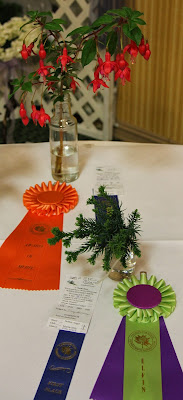Physocarpus (Ninebark)
is a useful landscape shrub, with cultivars to suit most Northwest gardens. This
graceful deciduous shrub is multi-stemmed, upright, and vase-shaped. Ninebark leaves
are alternate and simple, with three-to-five lobes. Cultivars of this North
American native plant have foliage ranging from chartreuse to purple. Clusters
of reddish flower buds open to white or pink flowers in late spring and attract
pollinators. In the fall, birds enjoy their small, seedy, and hairy berries. In
winter, the striped peeling bark on mature branches demonstrates how Physocarpus got its common name of
Ninebark.
Our native Pacific Ninebark (P. capitatus) is large and lanky, growing rapidly to 12’. In moist natural
areas, it supports birds and pollinators, and its extensive root system is good
for erosion control.
P. opulifolius cultivars provide outstanding color in
landscape gardens. Diabolo® Ninebark (P. opulifolius 'Monlo') was the first purple Ninebark on
the market. At 8’ x 8’, this shrub makes a great background plant. In the
spring, clusters of white flowers provide a beautiful contrast to the dark
chocolate to purple foliage. Add silver or white leafed plants nearby for
additional contrast.
Coppertina (P. opulifolius 'Mindia') has spectacular
copper-colored new foliage that ages to purple. It grows in a fountain shape to
8’ x 6’ and has light pink flowers. P. opulifolius ‘Center Glow’ has reddish
purple leaves with golden centers that gradually turn burgundy. With white
flowers, it has a graceful arching form to 8’ x 8’.
It is easier to find a place in the garden for the more
compact 5’ Summer Wine (P.
opulifolius 'Seward'), with orange springtime foliage transforming to
burgundy (pink flowers). Even smaller at 4’ x 3’, the dwarf Little Devil (P. opulifolius
'Donna May') has rich burgundy-purple leaves with pinkish-white flowers.
Contrast purple-leafed Ninebarks with gold, chartreuse, or
variegated foliage plants; or with bright hot-colored flowers or foliage, such
as lilies and cannas. In a large landscape, break up too much green with a
group of three to five purple Ninebarks.
Introduced to market in 2013, Amber Jubilee (P. opulifolius ’Jefam’)
produces spring growth in shades of yellow and orange, contrasting with lime
green foliage on mature branches. Fall foliage is red and purple, with size of
5’ x 4’. Similarly sized, with yellow to lime green foliage, both P. opulifolius ‘Dart’s Gold’ and P. opulifolius ‘Nugget’ have white
flowers. Afternoon shade protects gold-leafed types from leaf burning. Pops of
gold and chartreuse foliage brighten landscape areas.
Ninebarks are low maintenance plants that adapt to a range
of conditions – from sun to part shade, dry to moist, acidic to alkaline, and
nutrient-rich to poor soils. Prune occasionally to remove damaged branches or to
shape the plant. Remove old canes during dormancy to stimulate growth of vigorous
new branches with more flowers and better leaf size and color. (You may do renewal
pruning biannually to restrain plant size.) Plant a new Ninebark in your landscape!
This photo shows the new growth on Coppertina. I have three of these in my lower driveway berm.
This is the same Coppertina in the fall. Note the dramatic change in leaf color.
Here is our native Ninebark (
Physocarpus capitatus), planted in my native plant area:
This photo shows the golden leaves of the Nugget. It is planted in my lower driveway berm.










